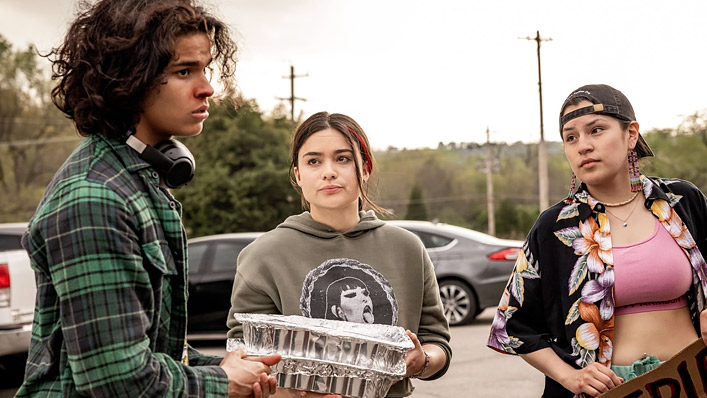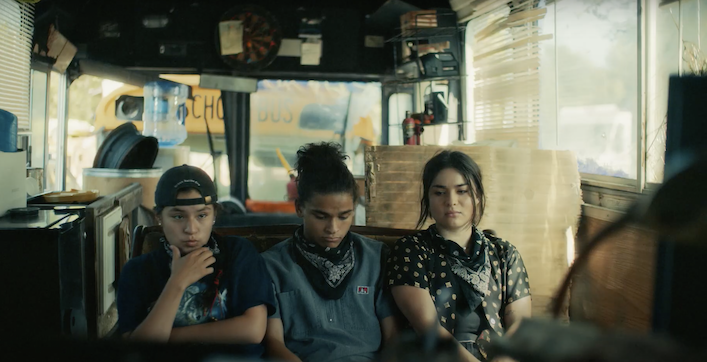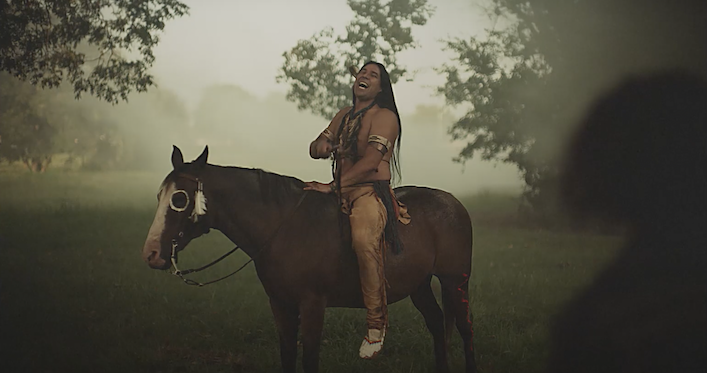The teen delinquents of Reservation Dogs reflect a fresh and funny Indigenous perspective

Set in a Native American reservation in Oklahoma, BINGE‘s new series Reservation Dogs has a strong sense of place—whilst also being flippin’ hilarious. Here’s Luke Buckmaster’s review.
The first episode of Sterlin Harjo and Taika Waititi’s snappily entertaining coming-of-age series kicks off with a heist scene featuring the kind of vehicle you don’t see nicked very often, or indeed see very much at all: a truck transporting cheese-flavoured chips. The riff-raff-ish gang of teenage delinquents behind this snack-themed thievery, around whom the show orbits, are smart enough to pull the job off—delivering the vehicle to a salvage yard and pocketing some dosh—yet dumb enough not only to eat the chips in public afterwards, but sell them for 50 cents a bag.
See also:
* All new streaming movies & series
* Movies now playing in cinemas
Location-establishing intro shots present rural Oklahoma, with accompanying audio from a radio DJ signposting the show’s setting in a Native American reservation (“hello everybody out there in Indian territory!”). This setting feels lived-in from the beginning, which is not to say these early images show much life: the railway yard is empty, the roads surrounding City Hall seemingly deserted.
The four young principal leads are visually revealed in a way regularly seen in movies and shows but rarely in real-life—their heads displayed in vertical arrangement, peeking around a corner. Bear (D’Pharaoh Woon-A-Tai), Elora Danan (Devery Jacobs), Willie Jack (Paulina Alexis) and Cheese (Lane Factor) mask up in bandanas, wait for the driver to leave the vehicle unattended, then jump in and hoon away in their hot, high-calorie ride. The head crook at the salvage yard pays them a compliment as well as cash, relaying that he’s heard they are “the best thieves in town.” Then he adds, “it is a small town.”
The setup front-loads action and escapade: a lead-footed injection of energy to make you sit up and pay attention. This intro is also tuned to characters, settings and socio-economic circumstance. It’s not some elaborate jewel heist and the kids are hardly seasoned professionals who meet in front of whiteboards. It is because of (rather than despite) these reasons that the scene has high stakes; we understand it’s an intense occasion in their lives.

The kids—brought to life by a fresh-faced attitude-filled cast—may be heisters and robbers, but they’re not bad people. The directors make a point, never needing to directly state it, that they’re still finding themselves, which I suppose is true of every teenager. These ones are of the ‘wrong side of the tracks’ ilk, but their criminality is borne from something deeper than mere mischief-making: they hate the community they live in and are saving up money so they can leave it.
If that sounds like a downer, au contraire: Reservation Dogs has pep and jive to spare. Its cheeky sense of humour imbues its slice-of-life naturalism with sass—like in the youth-themed skater dramedy Betty. It also includes such flourishes as breaks in realism that take you by surprise. After the group get shot by a rival gang during a drive-by, for instance, getting pelted with paintballs rather than bullets, Bear, knocked unconscious, is visited by one of his ancestors in a scene calibrated to parody racial clichés.

Riding topless on a horse, a peculiarly personable spirit warrior babbles to Bear about how he died at the battle of Little Bighorn—not in the sturm-und-drang of bloody conflict but after his horse sat on him. This sent the warrior to the cold spirit world—where “my nipples are always hard” and “I’m always hungry.” This scene reflects the broader experience of the show: flippant but dramatically meaningful; serious but sweet; playful but with something else lingering beneath the surface. This interaction causes Bear to question his ethics because, as the cold-nippled spirit warrior notes, “it’s easy to be bad” but “hard to be a warrior with dignity.”
Moments like these, which are internally significant in the narrative universe but look outwards, commentating on histories and cultural representations, are fresh and funny and loaded, reflecting a unique Indigenous perspective. Harjo told The New York Times that his intentions for making the series involved “teasing the audience using the history of cinema” because “Native Americans grow up on pop culture—it’s how we learn what the rest of the world is up to.”
That explains the show’s punny title, which is referenced when the gang dress up in suits, Mr White/Blonde/Orange/Pink/Blue/Brown style. Spending time with these kids is a hoot, the jocular mood never detracting from a credible, interesting central location. Reservation Dogs‘ strong sense of place and authentic portrayal of lower-class America reminded me of the excellent drama P-Valley. Sometimes you want to jump into this world to give these kids a helping hand, a friendly hello, a word of advice. Or simply to say: c’mon guys, put those chips down.

















